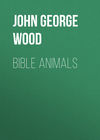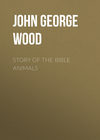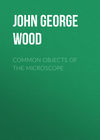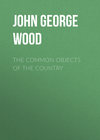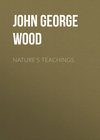Buch lesen: «Bible Animals», Seite 40
THE DHUBB
We now come to the second animal, which may probably be the Tzab of the Old Testament.
This creature is one of the lizards, and is a very odd-looking creature. It is certainly not so attractive in appearance that the Jews might be supposed to desire it as food; but it often happens that, as is the case with the turtle and iguana, from the most ungainly, in the latter animal even repulsive, forms are produced the most delicate meats.
The Dhubb, or Egyptian Mastigure, as the lizard is indifferently called, grows to a considerable size, measuring when adult three feet in length. Its colour is green, variegated with brown, and is slightly changeable, though not to the extent that distinguishes the chameleon. The chief peculiarity of this lizard consists in its tail, which is covered with a series of whorls or circles of long, sharply-pointed, hard-edged scales. The very appearance of this tail suggests its use as a weapon of defence, and it is said that even the dreaded cerastes is conquered by it, when the lizard and the snake happen to find themselves occupants of the same hole.
The ancients had a very amusing notion respecting the use of the spiny tail possessed by the Dhubb and its kin. They had an idea that, comparatively small though it was, it fed upon cattle, and that it was able to take them from the herd and drive them to its home. For this purpose, when it had selected an ox, it jumped on its back, and by the pricking of its sharp claws drove the animal to gallop in hope of ridding himself of his tormentor. In order to guide him in the direction of its home, it made use of its tail, lashing the ox "to make him go with his rider to the place of his most fit execution, free from all rescue of his herdsman, or pastor, or the annoyance of passengers, where, in most cruel and savage manner, he teareth the limbs and parts one from another till he be devoured."
This very absurd account is headed by an illustration, which, though bad in drawing and rude in execution, is yet so bold and truthful that there is no doubt that it was sketched from the living animal.
As it haunts sandy downs, rocky spots, and similar localities, it is well adapted for the Holy Land, which is the home of a vast number of reptiles, especially of those belonging to the lizards. In the summer time they have the full enjoyment of the hot sunbeams, in which they delight, and which seem to rouse these cold-blooded creatures to action, while they deprive the higher animals of all spirit and energy. In the winter time these very spots afford localities wherein the lizards can hibernate until the following spring, and in such a case they furnish the reptiles with secure hiding-places.
Although the Dhubb does not destroy and tear to pieces oxen and other cattle, it is yet a rather bloodthirsty reptile, and will kill and devour birds as large as the domestic fowl. Usually, however, its food consists of beetles and other insects, which it takes deliberately.
Whether or not the Dhubb be the same reptile as the Tzab of the Old Testament, the resemblance between the Hebrew and Arabic words is very remarkable.
THE LEVIATHAN OR CROCODILE
Signification of the word Leviathan—Description in the Book of Job—Structure and general habits of the Crocodile—The throat-valve and its use—Position of the nostrils—Worship of the Crocodile—The reptile known in the Holy Land—Two legends respecting its presence there—Mode of taking prey—Cunning of the Crocodile—The baboons and the Crocodile—Speed of the reptile—Eggs and young of the Crocodile, and their enemies—Curious story of the ichneumon and ibis—Modes of capturing the Crocodile—Analysis of Job's description—The Crocodile also signified by the word Tannin. Aaron's rod changed into a Tannin—Various passages in which the word occurs—Use of the word by the prophet Jeremiah.
The word Leviathan is used in a rather loose manner in the Old Testament, in some places representing a mammalian of the sea, and in others signifying a reptile inhabiting the rivers. As in the most important of these passages the Crocodile is evidently signified, we will accept that rendering, and consider the Crocodile as being the Leviathan of Scripture. The Jewish Bible accepts the word Crocodile, and does not add the mark of doubt.
The fullest account of the Leviathan occurs in Job xli., the whole of which chapter is given to the description of the terrible reptile. As the translation of the Jewish Bible differs in some points from that of the Authorized Version, I shall here give the former, so that the reader may be able to compare them with each other.
"Canst thou draw out a crocodile with a hook, or his tongue with a cord which thou lettest down?
"Canst thou put a reed into his nose, or bore his jaw through with a thorn?
"Will he make many supplications unto thee? will he speak soft words unto thee?
"Will he make a covenant with thee? wilt thou take him as a servant for ever?
"Wilt thou play with him as with a bird, or wilt thou bind him for thy maidens?
"Shall the companions make a banquet of him? shall they part him among the merchants?
"Canst thou fill his skin with barbed irons, or his head with fish-spears?
"Lay thine hand upon him, thou wilt no more remember the battle.
"Behold, the hope of him is in vain; shall not one be cast down at the sight of him?
"None is so fierce that dare stir him up; who then is able to stand before Me?
"Who hath forestalled Me that I should repay him? whatsoever is under the whole heaven is Mine.
"I will not be silent of his parts, nor of the matter of his power, nor of his comely proportion.
"Who can uncover the face of his garment? who would enter the double row in his jaw?
"Who can open the doors of his face? his teeth are terrible round about.
"The strength of his shields are his pride, shut up together as with a close seal.
"One is so near to another that no air can come between them.
"They are joined one to another, they stick together that they cannot be sundered.
"His snortings make light to shine, and his eyes are like the eyelids of the morning dawn.
"Out of his nostrils goeth smoke, as out of a seething pot or caldron.
"His breath kindleth live coals, and a flame goeth out of his mouth.
"In his neck abideth strength, and before him danceth terror.
"The flakes of his flesh are joined together, they are firm in themselves; yea, as hard as nether millstone.
"When he raiseth himself up, the mighty are afraid; by reason of breakings they lose themselves.
"The sword of him that layeth at him cannot hold: the spear, the dart, nor the habergeon.
"He esteemeth iron as straw, and copper as rotten wood.
"The arrow cannot make him flee: sling-stones are turned with him into stubble.
"Clubs are counted as stubble; he laugheth at the shaking of a spear.
"His under parts are like sharp points of potsherd; he speaketh sharp points upon the mire.
"He maketh the deep to boil like a pot; he maketh the sea like a pot of ointment.
"He maketh a path to shine after him; one would think the deep to be hoary.
"Upon earth there is not his like, who is made without fear.
"He beholdeth all high things; he is a king over all the children of pride."
This splendid description points as clearly to the Crocodile as the description of the Behemoth which immediately precedes it does to the hippopotamus, and it is tolerably evident that the sacred poet who wrote these passages must have been personally acquainted with both the Crocodile and the hippopotamus. In both descriptions there are a few exaggerations, or rather, poetical licences. For example, the bones of the hippopotamus are said to be iron and copper, and the Crocodile is said to kindle live coals with his breath. These, however, are but the natural imagery of an Oriental poet, and, considering the subject, we may rather wonder that the writer has not introduced even more fanciful metaphors.
Before proceeding with the Biblical portion of the history of this formidable reptile, I will mention a few points connected with the Crocodile and its kin. There are several species of Crocodile in different parts of the world, ten species at least being known to science. Some inhabit India, some tropical America, some Asia, and some Africa, so that the genus is represented in nearly all the warmer parts of the world.
They are all known by the formation of the teeth, the lower canines fitting each into a notch on the side of the upper jaw. The feet are webbed to the tips, and though the reptile mostly propels itself through the water by means of its tail, it can also paddle itself gently along by means of its feet. The teeth are all made for snatching and tearing, but not for masticating, the Crocodile swallowing its prey entire when possible; and when the animal is too large to be eaten entire, the reptile tears it to pieces, and swallows the fragments without attempting to masticate them.
In order to enable it to open its mouth under water, the back of its throat is furnished with a very simple but beautiful contrivance, whereby the water is received on a membranous valve, and, in proportion to its pressure, closes the orifice of the throat. As the Crocodiles mostly seize their prey in their open jaws and hold it under water until devoured, it is evident that without such a structure as has been described the Crocodile would be as likely to drown itself as its prey. But the throat-valve enables it to keep its mouth open while the water is effectually prevented from running down its throat, and the nostrils, placed at the end of the snout, enable it to breathe at its ease, while the unfortunate animal which it has captured is being drowned beneath the surface of the water.
This position of the nostrils serves another purpose, and enables the Crocodile to breathe while the whole of its body is under the water, and only an inch or two of the very end of the snout is above the surface. As, moreover, the Crocodile, as is the case with most reptiles, is able to exist for a considerable time without breathing, it only needs to protrude its nostrils for a few moments, and can then sink entirely beneath the water. In this way the reptile is able to conceal itself in case it should suspect danger; and as, in such instances, it dives under the herbage of the river, and merely thrusts its nose into the air among the reeds and rashes, it is evident that, in spite of its enormous size, it baffles the observation of almost every foe.
The Crocodile is one of the many animals to which divine honours were paid by the Egyptians. This we learn from several sources. Herodotus, for example, in "Euterpe," chapter 69, writes as follows: "Those who dwell about Thebes and Lake Mœris, consider them to be very sacred; and they each of them train up a Crocodile, which is taught to be quite tame; and they put crystal and gold ear-rings into their ears, and bracelets on their fore-paws; and they give them appointed and sacred food, and treat them as well as possible while alive, and when dead, they embalm them, and bury them in sacred vaults.
"But the people who dwell about the city of Elephantine eat them, not considering them as sacred."
The reasons for this worship are several. At the root of them all lies the tendency of man to respect that which he fears rather than that which he loves; and the nearer the man approaches the savage state, the more is this feeling developed. By this tendency his worship is regulated, and it will be found that when man is sufficiently advanced to be capable of worship at all, his reverence is invariably paid to the object which has the greatest terrors for him. The Crocodile, therefore, being the animal that was most dreaded by the ancient Egyptians, was accepted as the natural type of divinity.
By degrees, though the worship of the Crocodile was retained, the worshippers thought themselves obliged to find reasons for their veneration, and some of them said that they considered the Crocodile a type of divinity because it had no tongue, and was therefore an emblem of divine power, which requires no tongue wherewith to speak. "For by a mute and silent way it ascendeth, and bringeth all things mortal to a vocal justice, which speaketh in action, though not in voyce, even as all that is in the Crocodile is action and not voyce."
Some said that they reverenced the Crocodile because it laid threescore eggs and lived threescore years, this being the span of human life. Others, and these give by far the best reason, say that divine honours are paid to the Crocodile because the time of laying the eggs and hatching the young foreshows the annual rising of the Nile, on which depends the prosperity of the whole country. Still there is no doubt that, whatever explanations may have been offered by the advocates of Crocodile worship, the true reason for it was nothing but the terror inspired by the animal.
Owing to the accuracy of the description in the Book of Job, which is evidently written by one who was personally acquainted with the Crocodile, it is thought by many commentators that the writer must have been acquainted with the Nile, in which river both the Crocodile and hippopotamus are found at the present day.
It is possible, however, that the hippopotamus and the Crocodile have had at one time a much wider range than they at present enjoy. Even within the memory of man the hippopotamus has been driven further and further up the Nile by the encroachments of man. It has long been said that even at the present day the Crocodile exists in Palestine in the river which is called "Nhar Zurka," which flows from Samaria through the plains of Sharon. Several of the older writers have mentioned its existence in this river, and, since this work was commenced, the long-vexed question has been set at rest; a Crocodile, eight feet in length, having been captured in the Nhar Zurka.
In her "Domestic Life in Palestine," Miss Rogers gives an old legend by which the people account for the presence of Crocodiles in this river. Many ages ago there dwelt upon the bank of the river an old man and his two sons, the elder of whom was idle and profligate, while the younger was industrious and virtuous.
The father died, and left them each an equal share of his wealth—the flocks and herds which fed on the rich banks of the river. In process of time, the elder brother wasted all his property by riotous living and neglect, while the younger brother had greatly increased his flocks and herds, and had become a wealthy man. The elder, being jealous of his brothers prosperity, sought in his mind how to do him an injury. Accordingly, he travelled to Egypt, brought some young Crocodiles thence, and turned them into the river, hoping that they would destroy his brother's flocks as they came to drink.
Some time afterwards, he went down to the river, and, as he had been accustomed to do, descended to the water to wash, when the Crocodiles seized him, dragged him into the water, and devoured him.
This is one legend. Another states that many years ago a colony of Egyptians had settled on the bank of the Nhar Zurka, and that they, being worshippers of the Crocodile, brought some of the young from the Nile and established them in the river, which thenceforward bore the name of Nhar Zurka, or the Crocodile River. The reader will doubtless have noticed that in both these legends the Crocodile is said to be an importation from the Nile, and is not held to be indigenous to the river.
Allusion is made in the former of these two legends to the mode in which the Crocodile seizes its prey. It does not attack it openly, neither, as some have said, does it go on shore for that purpose. It watches to see whether any animal comes to drink, and then, sinking beneath the surface of the water, dives rapidly, rises unexpectedly beneath the unsuspecting victim, seizes it with a sudden snap of its huge jaws, and drags it beneath the water. Should the intended prey be too far from the water to be reached by the mouth, or so large that it may offer a successful resistance, the Crocodile strikes it a tremendous blow with its tail, and knocks it into the water. The dwellers on the Nile bank say that a large Crocodile will with a single blow of its tail break all the four legs of an ox or a horse.

THE CROCODILE, THE LEVIATHAN OF SCRIPTURE.
"Canst thou fill his skin with barbed irons? or his head with fish spears."—Job xli. 7.
These cunning reptiles even contrive to catch birds as they come for water. On the banks of the Nile the smaller birds drink in a very peculiar manner. They settle in numbers on the flexible branches that overhang the stream, and when, by their weight, the branch bends downwards, they dip their beaks in the water. The Crocodile sees afar off a branch thus loaded, swims as near as possible, and then dives until it can see the birds immediately above it, when it rises suddenly, and with a snap of its jaws secures a whole mouthful of the unsuspecting birds.
Sir S. Baker, in his travels on the Nile, gave much attention to the Crocodile, and has collected a great amount of interesting information about the reptile, much of which is peculiarly valuable, inasmuch as it illustrates the Scriptural notices of the creature. He states that it is a very crafty animal, and that its usual mode of attack is by first showing itself, then swimming slowly away to a considerable distance, so as to make its intended victim think that danger is over, and then returning under water. It is by means of this manœuvre that it captures the little birds. It first makes a dash at them, open-mouthed, causing them to take to flight in terror. It then sails slowly away as if it were so baffled that it did not intend to renew the attack. When it is at a considerable distance, the birds think that their enemy has departed, and return to the branch, which they crowd more than ever, and in a minute or two several dozen of them are engulfed in the mouth of the Crocodile, which has swiftly dived under them.
On one occasion, Sir S. Baker was walking near the edge of the river, when he heard a great shrieking of women on the opposite bank. It turned out that a number of women had been filling their "gerbas" (water-skins), when one of them was suddenly attacked by a large Crocodile. She sprang back, and the reptile, mistaking the filled gerba for a woman, seized it, and gave the owner time to escape. It then dashed at the rest of the women, but only succeeded in seizing another gerba.
A short time previously a Crocodile, thought by the natives to be the same individual, had seized a woman and carried her off; and another had made an attack on a man in a very curious manner. A number of men were swimming across the river, supported, after their custom, on gerbas inflated with air, when one of them felt himself seized by the leg by a Crocodile, which tried to drag him under water. He, however, retained his hold on the skin, and his companions also grasped his arms and hair with one hand, while with the other they struck with their spears at the Crocodile. At last they succeeded in driving the reptile away, and got their unfortunate companion to land, where they found that the whole of the flesh was stripped from the leg from the knee downwards. The poor man died shortly afterwards.
These crafty reptiles also try to catch the baboons by lying in wait for them at their drinking places; but the baboons are generally more than a match for the Crocodile in point of cunning and quickness of sight. Sir S. Baker witnessed an amusing example of such an attempt and its failure.
"The large tamarind-trees on the opposite bank are generally full of the dog-faced baboons (Cynocephalus) at their drinking hour. I watched a large Crocodile creep slily out of the water and lie in waiting among the rocks at the usual drinking place before they arrived, but the baboons were too wide awake to be taken in so easily.
"A young fellow was the first to discover the enemy. He had accompanied several wise and experienced old hands to the extremity of a bough that at a considerable height overhung the river; from this post they had a bird's eye view, and reconnoitred before one of the numerous party descended to drink. The sharp eyes of the young one at once detected the Crocodile, who matched in colour so well with the rocks that most probably a man would not have noticed it until too late.
"At once the young one commenced shaking the bough and screaming with all his might, to attract the attention of the Crocodile and to induce it to move. In this he was immediately joined by the whole party, who yelled in chorus, while the large old males bellowed defiance, and descended to the lowest branches within eight or ten feet of the Crocodile. It was of no use—the pretender never stirred, and I watched it until dark. It remained still in the same place, waiting for some unfortunate baboon whose thirst might provoke his fate, but not one was sufficiently foolish, although the perpendicular bank prevented them from drinking except at that particular spot."
It may be imagined that if the Crocodile were to depend entirely for its food upon the animals that it catches on the bank or in the river, it would run a risk of starving. The fact is, that its principal food consists of fish, which it can chase in the water. The great speed at which the Crocodile darts through the water is not owing to its webbed feet, but to its powerful tail, which is swept from side to side, and thus propels the reptile after the manner of a man "sculling" a boat with a single oar in the stern. The whales and the fishes have a similar mode of propulsion.
On land, the tail is the Crocodile's most formidable weapon. It is one mass of muscle and sinew, and the force of its lateral stroke is terrible, sweeping away every living thing that it may meet. Fortunately for its antagonists, the Crocodile can turn but very slowly, so that, although it can scramble along at a much faster pace than its appearance indicates, there is no great difficulty in escaping, provided that the sweep of its tail be avoided. As the Crocodile of the Nile attains when adult a length of thirty feet, one moiety of which is taken up by the tail, it may easily be imagined that the power of this weapon can scarcely be exaggerated.
As if to add to the terrors of the animal, its head, back, and tail are shielded by a series of horny scales, which are set so closely together that the sharpest spear can seldom find its way through them, and even the rifle ball glances off, if it strikes them obliquely. Like many other reptiles, the Crocodile is hatched from eggs which are laid on shore and vivified by the warmth of the sun.
These eggs are exceedingly small when compared with the gigantic lizard which deposited them, scarcely equalling in dimensions those of the goose. There is now before me an egg of the cayman of South America, a fresh-water lizard but little smaller than the Crocodile of the Nile, and this is barely equal in size to an ordinary hen's egg. It is longer in proportion to its width, but the contents of the two eggs would be as nearly as possible of the same bulk. On the exterior it is very rough, having a granulated appearance, not unlike that of dried sharkskin, and the shell is exceedingly thin and brittle. The lining membrane, however, is singularly thick and tough, so that the egg is tolerably well defended against fracture.
When first hatched, the young Crocodile is scarcely larger than a common newt, but it attains most formidable dimensions in a very short time. Twenty or thirty eggs are laid in one spot, and, were they not destroyed by sundry enemies, the Crocodiles would destroy every living creature in the rivers. Fortunately, the eggs and young have many enemies, chiefly among which is the well-known ichneumon, which discovers the place where the eggs are laid and destroys them, and eats any young Crocodiles that it can catch before they succeed in making their way to the water.
The old writers were aware of the services rendered by the ichneumon, but, after their wont, exaggerated them by additions of their own, saying that the ichneumon enters into the mouth of the Crocodile as it lies asleep, and eats its way through the body, "putting the Crocodile to exquisite and intolerable torment, while the Crocodile tumbleth to and fro, sighing and weeping, now in the depth of water, now on the land, never resting till strength of nature faileth. For the incessant gnawing of the ichneumon so provoketh her to seek her rest in the unrest of every part, herb, element, throws, throbs, rollings, but all in vain, for the enemy within her breatheth through her breath, and sporteth herself in the consumption of those vital parts which waste and wear away by yielding to unpacificable teeth, one after another, till she that crept in by stealth at the mouth, like a puny thief, comes out at the belly like a conqueror, through a passage opened by her own labour and industry."
The author has in the long passage, a part of which is here quoted, mentioned that the ichneumon takes its opportunity of entering the jaws of the Crocodile as it lies with its mouth open against the beams of the sun. It is very true that the Crocodile does sleep with its mouth open; and, in all probability, the older observers, knowing that the ichneumon did really destroy the eggs and young of the Crocodile, only added a little amplification, and made up their minds that it also destroyed the parents. The same writer who has lately been quoted ranks the ibis among the enemies of the Crocodile, and says that the bird affects the reptile with such terror that, if but an ibis's feather be laid on its back, the Crocodile becomes rigid and unable to move. The Arabs of the present time say that the water-tortoises are enemies to the eggs, scratching them out of the sand and eating them.
We will now pass to the description of the Crocodile in the Book of Job.
In the beginning of that description, Job is asked in irony whether he can draw out Leviathan with a hook, or bore his jaw with a thorn. This is probably in allusion, not so much to the size and strength of the Crocodile, as to its cunning. At the present time the Arabs of the Nile assert that to catch a Crocodile with a hook is impossible. Mr. Lowth suggested to his boatmen that, if a large hook were baited with meat, a Crocodile might be caught. Yusef eagerly denied the possibility of such a capture: "Him too clever—crocodile looking out of his eye so" (making a squint)—"he see everything like one man, as crocodile like man—people thinking him was one man long time, very long time."
According to Herodotus, however, the Egyptians did take the Crocodile with a hook, which they first baited with a small pig, and let into the river, and then beat another pig so as to make it scream. The Crocodile, hearing the cries of the pig, swims to seize its prey, and swallows the baited hook instead of the living pig. As soon as it is caught, the hunters draw it on shore, and when it tries to attack them, they throw sand into its eyes so as to blind it. It is remarkable that the Arab hunters of the Nile still employ sand as their best defensive weapon when they have harpooned a hippopotamus and dragged it to the bank. The animal, finding that it cannot retreat, charges into the men, who repel it by throwing sand into its eyes.
The expression "boring his jaw with a thorn" probably refers to the fishermen's universal custom of stringing together the captured fish by a twig passed through the mouth. In the late Mr. Waterton's "Wanderings" there is an account of the method employed by the natives in catching the cayman, which is the Crocodile of tropical America. A steel hook was tried and found useless, but one of the natives made in a short time an ingenious hook, composed of four sharpened wooden spikes, with which he succeeded in catching the reptile, thus literally boring its jaw with a thorn.
Allusion is made to the impenetrable character of the scale in verses 7, 15, 16, 17, and from verses 26 to 30. Verse 8 is given better in the Jewish Bible than in the Authorized Version. "Lay thine hand upon him, thou wilt no more remember the battle." The same may be said of verse 22, which is thus rendered in the Authorized Version: "In his neck remaineth strength, and sorrow is turned into joy before him." The marginal reading gives the last verse as "sorrow rejoiceth." Neither of these expressions is very intelligible, but the rendering of the Jewish Bible is not only clear, but forcible. "In his neck abideth strength, and before him danceth terror."
In verse 13 the marginal translation is nearly the correct one: "Who can come to him within his double bridle?" and the Jewish Bible gives the real meaning of the passage, showing that allusion is made to the double rows of teeth in both jaws, those of the upper interlacing into those of the lower. "Who would enter the double (row) in his jaw?" this reading being carried out by the following verse: "Who can open the doors of his face? his teeth are terrible round about" (Jewish Bible).
The quick sight of the Crocodile is mentioned in verse 18, his eyelids being compared to the "eyes of the morning," this metaphor being further illustrated by the hieroglyphs, wherein the eye of the Crocodile is employed as the emblem of day-dawn. The impossibility of domesticating this terrible reptile is shown in verses 4 and 5: "Will he make many supplications unto thee? Will he speak soft words unto thee?
"Wilt thou play with him as with a bird? or wilt thou bind him for thy maidens?"
Allusion is evidently made to the disagreeable nature of its flesh, which is penetrated with a strong musky odour, in verse 6: "Shall the companions make a banquet of him? Shall they part him among the merchants?"
And lastly, the foam raised by the lashing of the Crocodile's mighty tail, and the wake that is left behind it as it urges itself through the water, are mentioned in verses 31 and 32.
